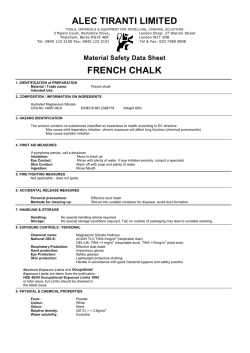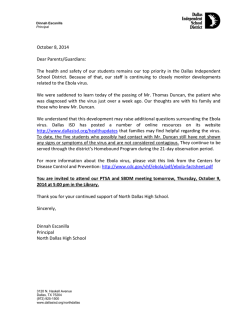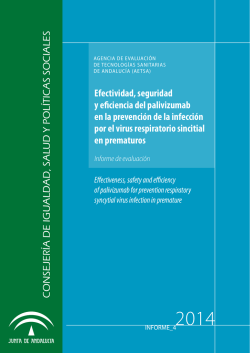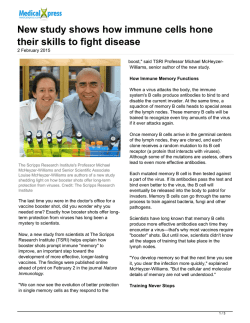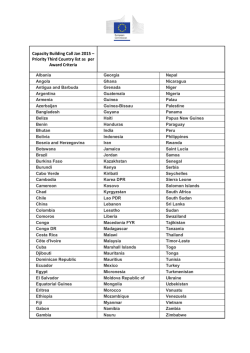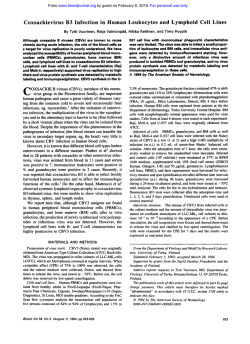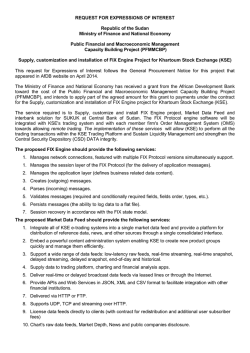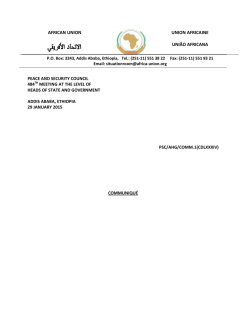
Detection and Molecular Characterization of Respiratory Syncytial
American Journal of Infectious Diseases and Microbiology, 2015, Vol. 3, No. 1, 6-13 Available online at http://pubs.sciepub.com/ajidm/3/1/2 © Science and Education Publishing DOI:10.12691/ajidm-3-1-2 Detection and Molecular Characterization of Respiratory Syncytial Virus (RSV) in Children with Respiratory Signs in Khartoum State, Sudan 2011-2012 Sahar O Khalil1,*, Khalid A Enan2, Ali. Y. H3, Bashir Salim4, Isam M Elkhidir5 1 Department of Microbiology, University of science and technology, P.O. Box: 30, Omdurman, Sudan Department of Virology, Central Laboratory, Ministry of science and Technology, P.O. Box 7099, Khartoum 3 Department of Virology, Veterinary research Institute, P.O. Box 80 67, Khartoum, Sudan 4 Department of Parasitology, Faculty of Veterinary Medicine, University of Khartoum, 13314 Khartoum-North, Sudan 5 Department of Microbiology and Parasitology, Faculty of Medicine, University of Khartoum, Khartoum, Sudan *Corresponding author: [email protected] 2 Received January 07, 2015; Revised January 27, 2015; Accepted February 01, 2015 Abstract Background: The present study was to investigate the incidence of the respiratory syncytial virus infection in children and to characterize the RSV circulating in Khartoum state during 2011-12 winter seasons. Methodology: Throat swab specimens collected from 224 children less than 5 years old, with respiratory tract infections admitted at Khartoum Hospitals in winter season (2011- 2012), were screened for RSV using direct immunofluorescence assay (DFA) and reverse transcription- polymerase chain reaction (RT-PCR). Isolation in cell culture followed by nucleotide sequencing and bioinformatics analysis based on the G gene, were done for the RTPCR positive RSV samples. Results: Out of 224 patients, RSV infections were detected in 136 (60.7%) patients, by using DFA technique, and 44 (19.6%) patients using RT-PCR. 22 strains of RSV were isolated in Hep-2 cell line. The clinical symptoms including Bronchiolitis, Pneumonia, Asthma and Allergy showed significantly different rates (p<0.05) in having RSV infection, (P-value = 0.017, 0.002, 0.0001, 0.0001) respectively. Bioinformatics analysis of nucleotide sequences of 7 cell culture isolated RSV strains revealed that all analyzed RSV belonged to the RSV-A genotype. Phylogenetic tree of RSV-A sequences showed that, all Sudanese strains were grouped with strains from Belgium and Saudi Arabia. Conclusions: This is the first report on molecular characterization that describes the circulation of RSV genotype in Sudan. DFA and RT-PCR offers rapid methods for detection of RSV in hospitalized children with Respiratory tract infection (RTI). Keywords: respiratory tract infection, respiratory syncytial viruses, reverse transcription polymerase chain reaction, direct immunofluorescence assay, khartoum Cite This Article: Sahar O Khalil, Khalid A Enan, Ali. Y. H, Bashir Salim, and Isam M Elkhidir, “Detection and Molecular Characterization of Respiratory Syncytial Virus (RSV) in Children with Respiratory Signs in Khartoum State, Sudan 2011-2012.” American Journal of Infectious Diseases and Microbiology, vol. 3, no. 1 (2015): 6-13. doi: 10.12691/ajidm-3-1-2. 1. Introduction Respiratory syncytial virus (RSV) is the most common cause of bronchiolitis and pneumonia among infants and children, particularly during the first year of life [1]. RSV is a negative-stranded non-segmented RNA virus in the genus Pneumovirus, subfamily Pneumovirinae of the family Paramyxoviridae [2]. The majority of children hospitalized for RSV infection are under 6 months of age [3]. RSV infections are responsible for 27-96% of hospitalized cases in developing countries [4], and about 100,000 infants are hospitalized annually in the United States alone [5,6]. RSV infections are also responsible for mortality, with almost nine times the mortality rate of influenza [7]. Developing countries had the highest mortality rates, with an estimated 66,000 to 199,000 deaths occurring in children younger than five years of age in 2005 [7]. RSV infections in temperate climates usually commence during the winter season, from October to December, as epidemics that may last for up to 5 months [8,9]. Although RSV has been recognized as an important pathogen, unfortunately no infant vaccine or antiviral treatment is presently available against RSV infections [10,11]. RSV subtypes A and B, are present in most outbreaks. Subtype A usually causes more severe disease [12,13], and is usually the predominantly circulating strain compared with subtype B strain [14,15]. Laboratory methods currently available for the detection of RSV include, virus isolation in cell culture, detection of viral antigens by direct or indirect immunofluorescent (IF) staining (DFA/IFA) or by enzyme-linked immunosorbent assays (ELISA) and the detection of viral nucleic acids by amplification assays American Journal of Infectious Diseases and Microbiology [16], mainly reverse transcription polymerase chain reaction (RT-PCR) which represent a rapid and sensitive method for detection of RSV compared to the other techniques [17]. In Sudan work on RSV is very sparse, little information is available about the Incidence of RSV infection in infant, however pneumonia was the first diseases leading to death in 2004, 2005 and 2006 in infants in Sudan [18]. We previously showed an overall sero-prevalence rate of RSV infection in 24 out of 92 (26%) infants with RTI. The sero-prevalence was higher in the 1-2 age groups (unpublished data). The present study aimed to investigate the incidence of respiratory syncytial virus (RSV) infection in Khartoum state from Gaffer Ebinauff and omdorman children hospitals, in infants and children under 5 years of age with respiratory tract infections (RTI) during 2011-12 winter seasons. The epidemiological data and molecular characterization of detected RSV genotype were analyzed. 2. Materials and Methods 2.1. Study Area The study was conducted in Khartoum State of Central Sudan, Patients involving children under 5 years of age with respiratory tract infection (RTI) seen at the emergency department in Khartoum Hospitals (Gaffer Ebinauff and omdorman children hospitals), were recruited between the 1st of January to the end of March in 2011 and 2012. 2.2. Data Collection Demographic data of the patients were collected using a structured questionnaire, which included the following criteria: Age, gender, and clinical symptoms (pneumonia, bronchiolitis, history of asthma and allergy). The specimens were collected within 1-7 days of disease onset. 7 finally dried then fixed using chilled acetone for 10 min and stored at -20°C for further work. DFA was carried out using specific fluoresce in conjugated monoclonal antibody (ARGENE Respiratory Syncytial Virus DFA kit, Varilhes, France) in accordance with the manufacturer’s instructions, for the detection and identification of RSV antigen in direct respiratory specimen. 2.5. RNA extraction and cDNA synthesis RNA was extracted using the Ribo-prep nucleic acid extraction kit (Ecolis.r.o., Bratislava, Slovak Republic), in accordance with the manufacturers protocol. The RNA was extracted from 100 μL of specimen and 10 μL of internal control was added to each sample. cDNA synthesis was performed using Reverta-L reagents kit, according to the protocol of the manufacturer (Ecolis.r.o., Bratislava, Slovak Republic) under the following conditions: The tested tubes were placed in the thermocycler and incubated at 37°C for 30 min. The cDNA samples were diluted by adding 20 µl from DNAbuffer. 2.6. RT-PCR for RSV The reverse transcription- polymerase chain reaction (RT-PCR) assay targeting G gene was performed using a commercial kit following the manufactures instructions (hRSV-Eph-PCR kit, Ecoli, Slovak Republic). The reaction was conducted in a thermocycler with block temperature adjustment, using the following protocol; 95°C for 5 min for initial denaturation, 42 cycles of 95°C for 45 s, 56°C for 45 s, and 72°C for 45 s, final extension at 72°C for 1 min. All the amplified products were subjected to 1.5% agarose gel electrophoresis. Positive specimens for RSV resulted in PCR fragments of 298 bp and the internal control resulted in PCR fragment of 550 pb. 2.7. Virus Isolation 2.3. Collection of Specimens A total of 224 throat swab samples (112 samples in each year)were collected from patients by using sterile nylon swabs (Regular Flocked swab, Cat. No. 520CS01, Copan Diagnostics Inc., Murrieta, Calif, USA) in 3 ml of transport media (UTM-RT, Cat. No. 92562, Copan Diagnostics Inc., Murrieta, Calif, USA). Samples collected were transported on ice at the same day of collection to the Department of Virology, Central Laboratory (Ministry of Science and Technology) and stored at −80°C until processed. 2.4. Direct Immunofluorescence Assay (DFA) Slides for DFA were prepared according to the manufacturer’s instructions (ARGENE Respiratory Syncytial Virus DFA kit, Varilhes, France), three times wash with PBS was done for the direct specimens, in which 5 ml of PBS was added to 0.5 ml of the secretions, pipetted gently and centrifuged at 180 g (1.200 rpm) for 10 min at 4°C. Then 30 μL of the suspension sediment was obtained on a slide for immunofluorescence purposes, Viral culture was done to the positive RSV samples by RT- PCR. Human epithelial type 2 (HEp-2) was obtained from (Vircell, Granada, Spain) and was grown at 37°C in 5% CO2 in modified Eagle's medium supplemented with 10% fetal bovine serum (FBS). 1 ml of each sample was inoculated in HEp-2 monolayer (60%–70% confluent) cultures and was maintained in modified Eagle's medium supplemented with 2% fetal bovine serum and 1% penicillin-streptomycin. Following adsorption, fresh medium was added, and inoculated cells were observed daily for cytopatic effect (syncytia) for up to 7 days. Virus was harvested when the monolayer demonstrated approximately 75% CPE (usually on days 3 or 4 postinoculation). The cells were subjected to three successive freeze-thaw cycles followed by re-suspension in fresh medium. The isolated virus was further purified with two rounds of centrifugation at 15000× g for 10 min at 4°C and then supernatants were collected and stored at −80°C. RT- PCR for (RSV) was then carried out to confirm virus identity. 2.8. Nested RT-PCR 8 American Journal of Infectious Diseases and Microbiology The Nested RT-PCR was carried out for the RT-PCR positive (RSV) samples including cell culture isolate using primer pairs located on the RSV G gene (Oligomicrogen, Korea). The following primers were used [19]: G1- CCA TTC TGG CAA TGA TAA TCT C G2- GTT TTT TGT TTG GTA TTC TTT TGC GA G3- CGG CAA ACC ACA AAG TCA CAC G4- GGG TAC AAA GTT AAA CAC TTC The primers G1 and G2 were used for the first round with 20 µL of PCR master mix (iNtRON BIOTECHNOLOGY, Korea) according to the manufacture instructions. The PCR was performed for 40 cycles, initially for 5 min at 95°C followed by, 1 min at 94°C, 1 min at 56°C and 1 min at 72°C, and finally 5 min of extension at 72°C for one cycle. For the 2nd round, 35 cycles was performed using G3 and G4 primers, initially for 5 min at 95°C followed by, 1 min at 94°C, 1 min at 56°C, 1 min at 72°C, and finally 5 min at 72°C for one cycle. The expected final Nested-PCR product was 326 bp. The Nested RT-PCR products were purified and sequenced by Macrogen’s sequencing service (Amsterdam, Netherlands). 2.9. Bioinformatics Analysis Seven consensus sequences of RSV isolates from children less than 5 years of age were successfully analyzed. The sequences were edited manually to correct possible base calling errors using BioEdit 7.0 [20], the sequences chromatogram was viewed by FinchTV1.4.0 program [21]. Then the nucleotides sequences of G genes were searched for sequences similarity using nucleotide BLAST [22]. Highly similar sequences were retrieved from NCBI and subjected to multiple sequence alignment using BioEdit software. Phylogenetic tree of G genes and their evolutionary relationship with those obtained from database was reconstructed using the maximum likelihood online by phylogeny.fr [23]. The seven sequences have been deposited with the Gene Bank under accession numbers (AB979187, AB979188, AB979189, AB979190, AB979191, AB979192 and AB979193). 2.10. Statistical Analysis The collected data was analyzed using statistical package for social science (SPSS) version 20, Chi square test was used, a p-value of <0.05 was considered significant. 3. Results 3.1. Detection of RSV During the study period, 224 children patients were enrolled. Out of these, 151 children were under 2 years of age and 73 were between 2-5 years of age. RSV infections were detected in 136 (60.7%) of these patients, using DFA technique (Table 1, Fig 1). A total of 224 swabs specimens were tested by RT-PCR, out of these RSV was detected in 44 (19.6%) patients. of which 30 (13.4%) patients were <2 years of age and 14 (6.2%) patients were 2-5 years of age (Table 1, Figure 1). There was no statistically significant association between age and RSV infection (P-value=0.903) (Table 1). Out of 44 positive samples by RT-PCR, 22 strains of RSV were isolated in Hep-2 cell line. The figure show percentage of positive and negative RSV cases detected by direct immunofluorescence assays (DFA) and reverse transcription- polymerase chain reaction (RT-PCR). Figure 1. Detection of Respiratory Syncytial Virus infection in children by RT-PCR and DFA Table 1. Age-related Respiratory Syncytial Virus Infection in Children in Khartoum state using DFA and RT-PCR techniques Age group DFA RT-PCR (years) Total Total Positive Negative Positive Negative <2 years 92 59 151 30 121 151 % Of Total 41.1% 26.3% 67.4% 13.4% 54.0% 67.4% 2-5 years 44 29 73 14 59 73 % Of total 19.6% 12.9% 32.6% 6.2% 26.3% 32.6% Total 136 88 224 44 180 224 % Of total 60.7% 39.3% 100% 19.6% 80.4% 100% P-value 0.925 0.903 - American Journal of Infectious Diseases and Microbiology 3.2. Detection of RSV in 2011-2012 9 In 2012 the RSV was detected in 75 (67%) samples using DFA and 23 (20.5%) samples using RT-PCR. The prevalence of RSV in 2011 was 61 (54.5%) using DFA technique and 21 (18.7%) using RT-PCR technique. Table 2. Seasons -related Respiratory Syncytial Virus Infection in Children in Khartoum state using DFA and RT-PCR techniques DFA RT-PCR Total Total Positive Negative Positive Negative 2011 61 51 112 21 91 112 % 54.5% 45.5% 100% 18.7% 81.3% 100% 2012 75 37 112 23 89 112 % 67% 33% 100% 20.5% 79.5% 100% Total 136 88 224 44 180 224 Seasons 3.3. Clinical Symptoms Associated RSV The clinical symptoms associated with RSV in positive patients were described in Table 3 and Figure 2. RSVpositive children under 2 years of age associated with Bronchiolitis, pneumonia, Asthma and Allergy, represented 12 (27.3%), 19 (43.2%), 3 (6.8%) and 1 (2.3%), respectively. RSV-positive children in 2-5 years of age were, 11 (25%), 2 (4.5%), 9 (20.5%), 8 (18.2%) respectively. The four clinical parameters showed significantly different rates (p<0.05) in having RSV infection, (P-value = 0.017, 0.002, 0.0001, 0.0001) for Bronchiolitis, Pneumonia, Asthma and Allergy, respectively (Table 3). Table 3. Clinical symptoms associated RSV-positive patients by RT-PCR in Khartoum state Bronchiolitis pneumonia Asthma Allergy Age group of +ve RSV children +ve -ve +ve -ve +ve -ve +ve -ve samples samples samples samples samples samples samples samples <2 years 12 18 19 11 3 27 1 29 % 27.3% 40.9% 43.2% 25% 6.8% 61.4% 2.3% 65.9% 2- 5 years 11 3 2 12 9 5 8 6 % 25% 6.8% 4.5% 27.3% 20.5% 11.4% 18.2% 13.6% Total 23 21 21 23 12 32 9 35 % 52.3% 47.7% 47.7 52.3% 27.3% 72.7% 20.5% 79.5% P-value 0.017 0.002 0.0001 0.0001 P-value = (0.017, 0.002, 0.0001, 0.0001) for Bronchiolitis, Pneumonia, Asthma and Allergy, respectively, all of them showed a significant difference. Figure 2. Distribution of positive RSV Patients according to clinical diagnosis using RT -PCR The figure show percentage of positive RSV cases in Khartoum hospitals with clinical symptoms (Bronchiolitis, Pneumonia, Asthma and Allergy) determined by reverse transcription- polymerase chain reaction (RT-PCR). 3.4. Gender associated RSV According to the gender, RSV was detected in 29 (12.9%) male and 15 (6.7%) female patients, using RTPCR technique (Table 4). However our study showed that there was no statistically significant difference between males and females in having RSV infection (Pvalue=0.699) (Table 4). Table 4. Respiratory syncytial virus positive cases in male and female patients by using RT-PCR RSV Gender Total P-value Positive Negative Male 29 113 142 % Of Total 12.9% 50.4% 63.4% Female 15 67 82 0.699 % Of Total 6.7% 29.9% 36.6% Total 44 180 224 % Of Total 19.6% 80.4% 100% 3.5. Nucleotide Sequence and Bioinformatics Analysis of RSV 10 American Journal of Infectious Diseases and Microbiology Successful sequencing of HRSV based on G gene was done on 7 samples. Phylogenetic analysis of nucleotide sequences revealed that all analyzed RSV belonged to the RSV-A strain. The nucleotide sequences and their accession numbers in gene bank are shown in Table 5. Furthermore, on comparison with reference A2 strain (GenBank accession number M74568) and others strains from gene bank, transversionmutation was identified in Sample name Isolate 17 Isolate 127 Isolate 129 Isolate 316 Isolate 354 Isolate 372 Isolate 395 one of the Sudanese viruses (Isolate 316) at position 220 were C was replaced by A (Figure 3). The Sudanese nucleotide sequences were compared with other sequences published in Gene Bank. Phylogenetic tree that were generated for RSV subtype-A are shown in Figure 4. The Sudanese RSV-A strains belonged to the same clade with JX645826 A strain (Belgium) and JX131640 A strain (Saudi Arabia) (Figure 4). Table 5. Sudanese Respiratory Syncytial virus (RSV) Sequences and Related information Date of collection Age Gender Genebank accession number 29-12-2011 4y M AB979187 29-01-2011 4y M AB979188 29-01-2011 2y F AB979189 16-01-2012 5y F AB979190 07-02-2012 2m F AB979191 11-02-2012 3m M AB979192 19-02-2012 1y M AB979193 Figure 3. chromatogram and multiple sequence alignment A. PCR amplification of G gene of RSV on 1.5% agarose gel electrophoresis. Lane M DNA ladder: MW 100 bp. Lane PC; positive control. Lane NC; negative control, Lane 1, 2, 6 and 7 showing typical band size of (326 pb) corresponding to the molecular size of G genes, 3, 4, 5 and 8 negative samples. B. Sequences chromatogram of isolate 316 shown by Finch TV software. C. BioEdit multiple sequence alignment. There is transversionmutation in which C was replaced by A illustrated by the arrows. Alignment of G gene sequences was undertaken with BioEdit software. Sequences were aligned with 17 sequences of RSV subgroup A downloaded from gene bank. The phylogenic tree was designed using phylogeny.fr software. 4. Discussion Figure 4. Phylogenetic analysis of the RSV G gene Over the past decade, number of studies has confirmed that RSV represents a substantial burden of acute respiratory tract illness particularly in the early years of life leading to severe morbidity and hospitalization in children [24,25,26]. Knowledge of the RSV molecular American Journal of Infectious Diseases and Microbiology epidemiology in Sudan is narrow. However, data collected from annual records of Ministry of Health [18] in Sudan showed that, within the ten top listed diseases causing hospitalization in infants, Pneumonia accounted for (28.330%) during 2004-2008. Asthma accounted for (1.8-2.5%) during 2004-2007 while acute bronchitis accounted for (2%) in 2008. The reports showed that pneumonia was the first disease leading to death during 2004, 2005 and 2006 accounting for 1126, 918, 814 deaths respectively. A recent study in Khartoum state reported that, the RSV infection was detected in 27 out of 334 patients that were negative for influenza viruses [27]. We in here, provides the first report on molecular detection and characterization of RSV in Sudan. In this study we investigated the incidence of respiratory syncytial virus (RSV) infection and characterized the RSV circulating in Khartoum state, during winter. Two hundred and twenty four of samples were collected from children with RTI and significantly high rate of RSV infection was detected by RT-PCR, where by 44 (19.6%) were reported as positive cases. Similar result were recorded in Egypt in which, RSV was detected in 16.4% of the cases [28]. However, lower incidence were reported from Kenya where 166 out of 2143 (8%), and from India where 21 out of 200 (10%) were confirmed positive for RSV infection [29,30]. A limitation of these latter results is that there was a possibility of missing cases due to no visit to the clinic because of mild symptoms and considerable distances between villages and hospitals. The high rate of RSV in our result explains the increase in RTI cases during winter seasons in Khartoum state. The present study showed that the prevalence rate of RSV was 136 (60.7%) using DFA and 44 (19.6%) using RT-PCR, this variation in the result between the two techniques was due to the fact that the DFA technique was less sensitive method as compared to RT-PCR that has shown improved sensitivity in the detection of RSV infection [31,32]. The current study showed that the prevalence of RSV was high in 2012 than in 2011 by the two techniques (DFA and RT-PCR), were 75 (67%) and 23 (20.5%) respectively. This result may possibly due to the significant variation in RSV outbreaks from year to year [33]. In addition, there is no awareness to prevent the RSV in Sudan. Although the bronchiolitis is a prominent sign for clinical diagnosis of patients with RSV infection especially in infants [34]. However, our results showed that pneumonia was the most frequent clinical diagnoses in hospitalized RSV cases in age group <2 years, constituting 19 (43.2%). The Bronchiolitis was the main clinical diagnosis in RSV cases in age group 2-5 years, it were 11 (25%). This variant with the results reported by RoyaNikfar [19], in which bronchiolitis was the most frequent clinical diagnoses in children younger than 2 years old, (33%). And pneumonia was the most frequent clinical diagnoses in children from 2-5 years old, (34%). The variation in our result may be due to the fact that, acute bronchiolitis children are at risk for developing pneumonia. Statistical analysis showed significant difference in different clinical symptoms, Bronchiolitis, Pneumonia, Asthma and Allergy (P-value = (0.017, 0.002, 0.0001, 0.0001, respectively). 11 Various studies suggest that male children are more susceptible to severe RSV infection than females [35,36]. Parallel results were obtained in our study; in which higher percentage of RSV-infected children were males. However, statistical analysis on clinical features and hospitalization with RSV rates between male and female patients did not reveal any striking differences. The present findings show that the RSV was of higher prevalence rate in group of <2 years 13.4%, than in 2-5 years 6.2%, These findings are in agreement with previous study in Brazil [37], in which a high rate of RSV infection was in children younger than 2 year of age. Strongly suggesting that the RSV is more likely to infect the age group <2 years [38]. Our data indicated that RSV subtype A is the predominant subtype circulating in Sudan, since all the analyzed samples were from hospitalized outpatients who came from different areas of the country. Previous studies in Taiwan and Brazil have also documented that Subtype A usually is the predominant circulating strains compared with subtype B [39,40]. Transversionmutation in G gene was identified in one of the Sudanese strains (Isolate 316). Several studies of RSV strains have described many mutations in G gene in different positions [41,42,43]. The Sudanese RSV viruses are closer to the previous described strains in Saudi Arabia, and that is mainly due to the short distance between Sudan and Saudi Arabia beside the great number of Sudanese people who travel to and from Saudi Arabia for Hajj, umrah and mostly for work. Furthermore, our viruses are also very close to Belgium viruses, a fact that is hard to explain, in view of the fact that Belgium is far than many other European countries such as France, Germany and Italy, in which other different RSV strains are circulating [44,45,46]. Moreover, no identical sequences to the Sudanese isolates could be found in Gene Bank. This is plausible because limited sequence data is available at present time on the prevalence of RSV in Africa, which are more likely to share the same genotypes. Our earlier studyon the prevalence of RSV infection in infants in Sudan showed that, RSV antibodies were more likely to be detected in re infected infants (28.8%) with respiratory infections than in first time infected infants (8.3%) (Unpublished data).Since we did not address this question in our present study, it is hard to make any comparison with our earlier study in regard to prevalence of RSV in cases of re infection. 5. Conclusion In conclusion, this is the first report on the molecular epidemiology of RSV associated RTI in Sudan. It highlights the significance of RSV as a dominant etiologic agent contributing towards morbidity and mortality especially in young children in Sudan, and need for further work on incidence of viral pneumonias and their impact on public health. The detection and characterization of RSV infection may help to further our understanding with respect to acute respiratory infections of children. Acknowledgements 12 American Journal of Infectious Diseases and Microbiology The authors gratefully acknowledge the Staff of Khartoum Hospital for allowing us to collect the samples, and Central lab for their help in practical work. We thank prof. Abdlrahim for the manuscript corrections and Dr.HishamAltayb for his work on bioinformatics anaylisis. We are grateful to the children and parents that approved to provide samples for this study from Khartoum hospital. [9] Conflict of Interest [12] [10] [11] All authors declare that none of them have any conflict of interest. [13] Authors’ Contributions SOK carried out the sample collection, virus isolation, DFA, RT-PCR, and drafted the manuscript. BS designed the alignment and phylogenetic analysis. A B M did the Statistical analysis. KAE helped in the work of virus isolation, RT-PCR and help in the drafting of the manuscript. IME and YHI supervised the work and drafting of the manuscript. All authors read and approved the final manuscript. [14] [15] [16] Ethical Clearance [17] The study was approved by the Ethical Review Committee (ERC) of the Ministry of Health Khartoum State, Sudan. Written consents were obtained from all parents of the patients. [18] [19] References [1] [2] [3] [4] [5] [6] [7] [8] Queiróz D.A.O, Durigon E.L, Botosso V.F, Ejzemberg B, Vieira S.E, Mineo J.R, Yamashita C, Hein N, Lopes C.L, Cacharo A.L and Stewien K.E: Immune response to respiratory syncytial virus in young brazilian children. Braz J MedBiol Res 2002, 35: 11831193. Collins, P.L., Crowe J. E. J: Respiratory syncytial virus and metapneumovirus, In Fields virology(ed.) D. M. Knipe, P. M. Howley, D. E. Griffin, R. A. Lamb, M. A. Martin, B. Roizman, and S. E. Straus, 5th ed. Lippincott Williams and Wilkins, Philadelphia, USA 2007 pp. 1601-1646. Thompson WW, Shay DK, Weintraub E, Brammer L, Cox N, Anderson LJ, Fukuda K: Mortality associated with influenza and respiratory syncytial virus in the United States. JAMA 2003, 289 (2): 179-186. Weber MW, Mulholland EK, Greenwood BM: Respiratory syncytial virus infection in tropical and developing countries. Trop Med Int Health 1998, 3 (4): 268-80. Shay DK, Holman RC, Newman RD, Liu LL, Stout JW, Anderson LJ: Bronchiolitis-associated hospitalizations among US children, 1980-1996. JAMA 1999, 282: 1440-6. Leader S, Kohlhase K: Recent trends in severe respiratory syncytial virus (RSV) among US infants, 1997 to 2000. J Pediatr 2003, 143:127-32. Nair H, Nokes DJ, Gessner BD, Dherani M, Madhi SA, Singleton RJ, O'Brien KL, Roca A, Wright PF, Bruce N, Chandran A, Theodoratou E,Sutanto A, Sedyaningsih ER, Ngama M, Munywoki PK, Kartasasmita C, Simões EA, Rudan I, Weber MW, Campbell H: Global burden of acute lower respiratory infections due to respiratory syncytial virus in young children: A systematic review and meta-analysis. Lancet 2010, 375: 1545-55. Cane PA, Matthews DA, Pringle CR: Analysis of relatedness of subgroup A respiratory syncytial virus isolated worldwide. Virus Res 1992, 25: 15-22. [20] [21] [22] [23] [24] [25] [26] [27] [28] [29] [30] Roca A, Loscertales MP, QuintóL, Pérez-Breña P, Vaz N, Alonso PL, Saiz JC: Genetic variability among group A and B respiratory syncytial viruses in Mozambique: Identification of a new cluster of group B isolates. J Gen Virol 2001, 82: 103-111. Ghafoor A, Nomani NK, Ishaq Z, Zaidi SZ, Anwar F, Burney MI, Qureshi AW, Ahmad SA: Diagnoses of acute lower respiratory tract infections in children in Rawalpindi and Islamabad, Pakistan. Rev Infect Dis 1990, 12 (8): S907-S914. McLellan JS, Yang YP, Graham BS, Kwong PD: Structural basis of respiratory syncytial virus neutralization by motavizumab. Nat StructMolBiol 2010, 17: 248-250. Papadopoulos NG, Gourgiotis D, Javadyan A,Bossios A, KallergiK, Psarras S,TsoliaMN, KafetzisD: Does respiratory syncytial virus subtype influences the severity of acute bronchiolitis in hospitalized infants? Respir Med 2004, 98 (9): 879-882. Gilca R, De Serres G, Tremblay M, Vachon ML, Leblanc E, Bergeron MG, Dery P, Boivin G: Distribution and clinical impact of human respiratory syncytial virus genotypes in hospitalized children over 2 winter seasons. J Infect Dis 2006, 193 (1): 54-58. Peret TC, Hall CB, Hammond GW, Piedra PA, Storch GA, Sullender WM, Tsou C, Anderson LJ:Circulation patterns of group A and B human respiratory syncytial virus genotypes in 5 communities in North America. J Infect Dis 2000, 181 (6): 18911896. Hall CB, Walsh EE, Schnabel KC, Long CE, McConnochie KM, Hildreth SW, Anderson LJ: Occurrence of groups A and B of respiratory syncytial virus over 15 years: associated epidemiologic and clinical characteristics in hospitalized and ambulatory children. J Infect Dis 1990, 162 (6): 1283-1290. Henrickson K.J: Advances in the laboratory diagnosis of viral respiratory disease. Pediatr. Infect. DisJ 2004, 23: S6-S10. Empey K.M, Peebles R.S, Jr, Kolls J.K: Pharmacologic advances in the treatment and prevention of respiratory syncytial virus. Clin. Infect. Dis 2010, 50: 1258-1267. Anon:Annual Reports of Ministry of Health, Sudan. 2004-2008. RoyaNikfar, Ahmad Shamsizadeh, ManoochehrMakvandi and ArashKhoshghalb: Detection of Respiratory Syncytial Virus in Hospitalized Children with Acute Lower Respiratory Tract Infections, Using RT PCR in Ahvaz, Iran. Archives of Pediatric Infectious Diseases 2013, 1 (3): 118-21. Thomas A. Hall: Bio Edit: a user-friendly biological sequence alignment editor and analysis program for windows 95/98/NT. Nucleic Acid Symposium 1999, 41: 95-98. http://www.geospiza.com/Products/finchtv.shtml http://blast.ncbi.nlm.nih.gov/Blast.cgi http://www.phylogeny.fr/ Venter M, Madhi SA, Tiemessen CT, Schoub BD: Genetic diversity and molecular epidemiology of respiratory syncytial virus over four consecutive seasons in South Africa: identification of new subgroup A and B genotypes. J Gen Virol 2001, 82: 21172124. McLellan JS, Yang YP, Graham BS, Kwong PD: Structural basis of respiratory syncytial virus neutralization by motavizumab. Nat StructMolBiol 2010, 17: 248-250. McLellan JS, Chen M, Chang JS, Yang Y, Kim A, Graham BS, Kwong PD:Structure of a major antigenic site on the respiratory syncytial virus fusion glycoprotein in complex with neutralizing antibody 101F. J Virol 2010, 84: 12236-12244. Khalid A Enan, Takeshi Nabeshima, Toru Kubo, Corazon C Buerano, Abdel Rahim M El Hussein, Isam M Elkhidir, Eltahir AG Khalil and Kouichi Morita: Survey of causative agents for acute respiratory infections among patients in Khartoum-State, Sudan, 2010-2011. Virology Journal 2013, 10: 312. Aya M Fattouh, Yasmeen A Mansi, Mervat G El-anany, Amany A El-kholy and Hanaa M El-karaksy: Acute lower respiratory tract infection due to respiratory syncytial virus in a group of Egyptian children under 5 years of age. Journal of Pediatrics 2011, 37: 14. Emelda A. Okiro, MwanajumaNgama, Ann Bett, JamesNokes D:The Incidence and Clinical Burden of Respiratory Syncytial Virus Disease Identified through Hospital Outpatient Presentations in Kenyan Children. PLOS ONE 2012, 7 (12): e52520. Maitreyi S. Rajala, Wayne M. Sullender, Prasad A. K, Lalit Dar and ShobhaBroor: Genetic Variability among Group A and B Respiratory Syncytial Virus Isolates from a Large Referral Hospital in New Delhi, India. J. Clin. Microbiol 2003, 41 (6): 2311. American Journal of Infectious Diseases and Microbiology [31] Marcos MA, Esperatti M, Torres A: Viral pneumonia. CurrOpin [32] [33] [34] [35] [36] [37] [38] Infect Dis 2009, 22: 143-147. Reis AD, Fink MCD, Machado CM, Paz JP, Oliveira RR, Tateno AF, Machado AF, Cardoso MR, Pannut CS: Comparison of direct immunofluorescence, conventional cell culture and polymerase chain reaction techniques for detecting respiratory syncytial virus. Rev Inst Med Trop S Paulo 2008, 50: 37-40. Elena Terletskaia-Ladwig, Gisela Enders, Gunnar Schalasta and Martin Enders: Defining the timing of respiratory syncytial virus (RSV) outbreaks: an epidemiological study. BMC infectious Dis 2005, 10: 5-20. Cabello C, Manjarrez ME, Olvera R, Villalba J, Valle L, Paramo I: Frequency of viruses associated with acute respiratory infections inchildren younger than five years of age at a locality of Mexico. City. MemInst Oswaldo Cruz 2006, 101 (1): 21-4. Eshaghi A, Duvvuri VR, Lai R, Nadarajah JT, Li A, Aimin Li, Samir N. P, Donald E. l, Jonathan B: Genetic Variability of Human Respiratory Syncytial Virus A Strains Circulating in Ontario: A Novel Genotype with a 72 Nucleotide G Gene Duplication. PLOS ONE 2012, 7 (3): e32807. Goto-Sugai K, Tsukagoshi H, Mizuta K, Matsuda S, Noda M, Sugai T, Saito Y, Okabe N, Tashiro M, Kozawa K, Tanaka R, Morita Y,Nishina A, Kimura H:Genotyping and phylogenetic analysis of the major genes in respiratory syncytial virus isolated from infants with bronchiolitis. Jpn J Infect Dis 2010, 63: 393-400. Letí cia Martins Lamarão, Francisco Luzio Ramos, WyllerAlencar Mello, MirleideCordeiro Santos, LuanaSoaresBarbagelata, Maria CleoniceAguiarJustino, Alexandre Ferreira da Silva, Ana Judith Pires Garcia Quaresma, Veronilce Borges da Silva, Rommel Rodríguez Burbano1 and Alexandre Costa Linhares: Prevalence and clinical features of respiratory syncytial virus in children hospitalized for community-acquired pneumonia in northern Brazil. Infectious Diseases 2012, 12: 119. D´Elia C, Siqueira MM, Portes SA, Sant’Anna CC: Respiratory syncytial ví rus associated lower respiratory tract infections in hospitalized infants. Rev Soc Bras Med Trop 2005, 38: 7-10. 13 [39] Lee JT, Chang LY, Wang LC, Kao CL, Shao PL, Lu CY, Lee PI, [40] [41] [42] [43] [44] [45] [46] Chen JM, Lee CY, Huang LM: Epidemiology of respiratory syncytial virus infection in northern Taiwan, 2001-2005seasonality, clinical characteristics, and disease burden. J MicrobiolImmunol Infect 2007, 40: 293-301. Moura FEA, Borges LC, Portes SAR, Ramos EAG, Siqueira MM:Respiratory syncytial virus infections during an epidemic period in Salvador, Brazil. Viral antigenic group analysis and description of clinical and epidemiological aspects. MemInstOswaldo Cruz 2003, 98: 739-743. IsidoroMartı!nez, OdalysValde!s, Adriana Delfraro, Juan Arbiza, Jose! Russi and Jose! A. Melero: Evolutionary pattern of the G glycoprotein of human respiratory syncytial viruses from antigenic group B: the use of alternative termination codons and lineage diversification. J. Gen. Virol 1999, 80 (Pt. 1): 125-130. Trento A, Viegas M, Galiano M, Videla C, Carballa G, Mistchenko AS, Melero JA: Natural history of human respiratory syncytial virus inferred from phylogenetic analysis of the attachment (G) glycoprotein with a 60-nucleotide duplication. J. Virol 2006, 80: 975-984. AliRezaEshaghi, Venkata R. Duvvuri, Rachel Lai, Jeya T. Nadarajah, Aimin Li, Samir N. Patel, Donald E. Low, Jonathan B: Genetic Variability of Human Respiratory Syncytial Virus A Strains Circulating in Ontario: A Novel Genotype with a 72 Nucleotide G Gene Duplication. Plos One 2012, 10:1371. Gouyon JB, Pothier P, Guignier F, Portier H, Pujol HP, Kazmierczak A, Chatelain P, Alison M: Outbreak of respiratory syncytial virus in France. EurJClin Microbiol 1985, 4 (4):415-416. Weigl JA, Puppe W, Rockahr S, Schmitt HJ: Burden of disease in hospitalized RSV-positive children in Germany. KlinPadiatr 2002, 214 (6): 334-342. Pierangeli A,TrottaD, ScagnolariC, FerreriML, NicolaiA, MidullaF, MarinelliK, AntonelliG, BagnarelliP: RAPID SPREAD OF THE NOVEL RESPIRATORY SYNCYTIAL VIRUS A ON1 GENOTYPE, CENTRAL ITALY, 2011 TO 2013. Eurosurveillance 2013, 19 (26): 20843.
© Copyright 2025
